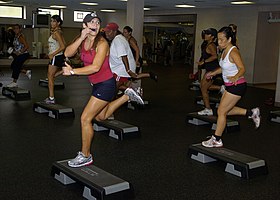Fizička vežba — разлика између измена
. |
(нема разлике)
|
Верзија на датум 24. новембар 2019. у 07:51
Један корисник управо ради на овом чланку. Молимо остале кориснике да му допусте да заврши са радом. Ако имате коментаре и питања у вези са чланком, користите страницу за разговор.
Хвала на стрпљењу. Када радови буду завршени, овај шаблон ће бити уклоњен. Напомене
|
Fizička vežba je svaka telesna aktivnost koja poboljšava ili održava physical fitness and overall health and wellness.[1]
It is performed for various reasons, to aid growth and improve strength, preventing aging, developing muscles and the cardiovascular system, honing athletic skills, weight loss or maintenance, improving health[2] and also for enjoyment. Many individuals choose to exercise outdoors where they can congregate in groups, socialize, and enhance well-being.[3]
In terms of health benefits, the amount of recommended exercise depends upon the goal, the type of exercise, and the age of the person. Even doing a small amount of exercise is healthier than doing none.[4]
Klasifikacija

Fizičke vežbe se generalno grupišu u tri tipa, zavisno od sveukupnog uticaja koji imaju na ljudsko telo:[5]
- Aerobic exercise is any physical activity that uses large muscle groups and causes the body to use more oxygen than it would while resting.[5] The goal of aerobic exercise is to increase cardiovascular endurance.[6] Examples of aerobic exercise include running, cycling, swimming, brisk walking, skipping rope, rowing, hiking, dancing, playing tennis, continuous training, and long distance running.[5]
- Anaerobic exercise, which includes strength and resistance training, can firm, strengthen, and increase muscle mass, as well as improve bone density, balance, and coordination.[5] Examples of strength exercises are push-ups, pull-ups, lunges, squats, bench press. Anaerobic exercise also include weight training, functional training, eccentric training, interval training, sprinting, and high-intensity interval training increase short-term muscle strength.[5][7]
- Flexibility exercises stretch and lengthen muscles.[5] Activities such as stretching help to improve joint flexibility and keep muscles limber.[5] The goal is to improve the range of motion which can reduce the chance of injury.[5][8]
Physical exercise can also include training that focuses on accuracy, agility, power, and speed.[9]
Types of exercise can also be classified as dynamic or static. 'Dynamic' exercises such as steady running, tend to produce a lowering of the diastolic blood pressure during exercise, due to the improved blood flow. Conversely, static exercise (such as weight-lifting) can cause the systolic pressure to rise significantly, albeit transiently, during the performance of the exercise.[10]
Reference
- ^ Kylasov A, Gavrov S (2011). Diversity Of Sport: non-destructive evaluation. Paris: UNESCO: Encyclopedia of Life Support Systems. стр. 462—91. ISBN 978-5-89317-227-0.
- ^ „7 great reasons why exercise matters”. Mayo Clinic (на језику: енглески). Приступљено 2. 11. 2018.
- ^ Bergstrom, Kristine; Muse, Toby; Tsai, Michelle; Strangio, Sebastian. „Fitness for Foreigners”. Slate Magazine. Slate Magazine. Приступљено 5. 12. 2016.
- ^ „Exercise”. UK NHS Live Well (на језику: енглески). 2018-04-26. Приступљено 2019-11-13.
- ^ а б в г д ђ е ж National Institutes of Health, National Heart, Lung, and Blood Institute (јун 2006). „Your Guide to Physical Activity and Your Heart” (PDF). U.S. Department of Health and Human Services.
- ^ Wilmore J.; Knuttgen H. (2003). „Aerobic Exercise and Endurance Improving Fitness for Health Benefits”. The Physician and Sportsmedicine. 31 (5): 45—51. PMID 20086470. doi:10.3810/psm.2003.05.367.
- ^ De Vos N.; Singh N.; Ross D.; Stavrinos T. (2005). „Optimal Load for Increasing Muscle Power During Explosive Resistance Training in Older Adults”. The Journals of Gerontology. 60A (5): 638—47. PMID 15972618. doi:10.1093/gerona/60.5.638.
- ^ O'Connor D.; Crowe M.; Spinks W. (2005). „Effects of static stretching on leg capacity during cycling”. Turin. 46 (1): 52—56.
- ^ „What Is Fitness?” (PDF). The CrossFit Journal. октобар 2002. стр. 4. Приступљено 12. 9. 2010.
- ^ de Souza Nery S, Gomides RS, da Silva GV, de Moraes Forjaz CL, Mion D Jr, Tinucci T (1. 3. 2010). „Intra-Arterial Blood Pressure Response in Hypertensive Subjects during Low- and High-Intensity Resistance Exercise”. Clinics. 65 (3): 271—77. PMC 2845767
 . PMID 20360917. doi:10.1590/S1807-59322010000300006.
. PMID 20360917. doi:10.1590/S1807-59322010000300006.
Literatura
- Dobbins, Maureen; Husson, Heather; DeCorby, Kara; LaRocca, Rebecca L (28. 2. 2013). Cochrane Database of Systematic Reviews. John Wiley & Sons, Ltd. стр. CD007651. PMID 23450577. doi:10.1002/14651858.cd007651.pub2.
- Hubal MJ, Gordish-Dressman H, Thompson PD, Price TB, Hoffman EP, Angelopoulos TJ, Gordon PM, Moyna NM, Pescatello LS, Visich PS, Zoeller RF, Seip RL, Clarkson PM (јун 2005). „Variability in muscle size and strength gain after unilateral resistance training”. Medicine & Science in Sports & Exercise. 37 (6): 964—72. PMID 15947721.
- Brutsaert TD, Parra EJ (2006). „What makes a champion? Explaining variation in human athletic performance”. Respiratory Physiology & Neurobiology. 151 (2–3): 109—23. PMID 16448865. doi:10.1016/j.resp.2005.12.013.
- Geddes, Linda (28. 7. 2007). „Superhuman”. New Scientist. стр. 35—41.
Spoljašnje veze
- Adult Compendium of Physical Activities – a website containing lists of Metabolic Equivalent of Task (MET) values for a number of physical activities, based upon PMID 8292105, 10993420 and 21681120
- Physical activity and the environment – guidance on the promotion and creation of physical environments that support increased levels of physical activity.
- MedLinePlus Topic on Exercise and Physical Fitness
- Science Daily's reference on physical exercise


